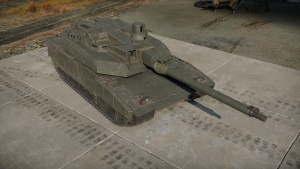Difference between revisions of "GIAT CN120-26 F1 (120 mm)"
(→Description: Filled up the page, didn't know all that much in terms of history so that is pretty...blank.) (Tag: Visual edit) |
m (→Pros and cons) |
||
| Line 88: | Line 88: | ||
* Effective kinetic energy round | * Effective kinetic energy round | ||
| − | |||
'''Cons:''' | '''Cons:''' | ||
* HEAT-FS stock; a very weak APFSDS shell is locked as a Tier I modification, but a much stronger one is a Tier IV modification | * HEAT-FS stock; a very weak APFSDS shell is locked as a Tier I modification, but a much stronger one is a Tier IV modification | ||
| − | |||
| − | |||
== History == | == History == | ||
Revision as of 21:03, 23 February 2021
Contents
Description
The GIAT CN120-26 F1 (also known as "Lisse") is a 120 mm anti-tank cannon, with a smoothbore barrel designed by EFAB de Bourges and manufactured by the French company GIAT. It was derived from the CN120-25 intended for the AMX-40 and it is only mounted on the Leclerc series of tanks.
It has a sliding vertical breechblock and it can also be distinguished by the absence of a fume extractor, instead, the gases are being evacuated by overpressure. However, the Tropicalized Leclerc of the Emirati Army uses a system of blowing compressed air into the chamber via a cannula, instead of the overpressure system that the French counterpart uses.
Vehicles equipped with this weapon
General info
On the outer layer of the cannon, there is a thermal insulation jacket and the length of the cannon is 6,931 mm, with a mass of around 2,800 kg. The maximum rate of fire can be 12 RPM, but in practice, this is more close to 10 RPM. It has a maximum gun depression of 18° and minimum gun depression of -7°. The maximum effective range is 4,000 m for the APFSDS shell, and roughly 3,000 m for the HEAT shell, albeit in practice, it is lower than that.
Available ammunition
| Penetration statistics | |||||||
|---|---|---|---|---|---|---|---|
| Ammunition | Warhead type | Penetration @ 0° Angle of Attack (mm) | |||||
| 10 m | 100 m | 500 m | 1,000 m | 1,500 m | 2,000 m | ||
| OCC 120 G1 | HEATFS | 480 | 480 | 480 | 480 | 480 | 480 |
| OFL 120 G1 | APFSDS | 394 | 393 | 388 | 382 | 376 | 370 |
| OFL 120 F1 | APFSDS | 575 | 573 | 565 | 557 | 547 | 537 |
| Shell details | |||||||||
|---|---|---|---|---|---|---|---|---|---|
| Ammunition | Warhead type | Velocity(m/s) | ProjectileMass (kg) | Fuse delay(m) | Fuse sensitivity(mm) | Explosive Mass(TNT equivalent) (g) | Ricochet chance | ||
| 0% | 50% | 100% | |||||||
| OCC 120 G1 | HEATFS | 1,100 | 14.4 | 0.0 | 0.1 | 2,148 | 65° | 72° | 77° |
| OFL 120 G1 | APFSDS | 1,650 | 3.8 | N/A | N/A | N/A | 78° | 80° | 81° |
| OFL 120 F1 | APFSDS | 1,790 | 3.8 | N/A | N/A | N/A | 78° | 80° | 81° |
Comparison with analogues
Give a comparative description of cannons/machine guns that have firepower equal to this weapon.
| Comparable cannons to the GIAT CN120-26 F1 | |||
|---|---|---|---|
| Name | Year of Production | RPM | Maximum Penetration(mm) |
| Rh120 L/55 | 1991 | 7 | 652 |
| Ordnance QF Tk. L1A2 | 1957 | 3 | 362 |
Usage in battles
The Leclerc's OFL 120 F1 round with its fast velocity of 1,790 m/s and high penetration power makes it excellent at fulfilling the sniping role. One should avoid rural combat as the Leclerc series of tanks are easily destroyed in close quarters battles, as its weaknesses are very visible. Finding a vantage point where most of your tank is covered is the most effective way to use the GIAT CN120-26.
But since the user starts out with a HEAT-FS as their stock round, at first one will have to play more aggressively up until they unlock the OFL 120 F1 round, but should still generally avoid close quarters confrontations and brawls.
Pros and cons
Pros:
- Very fast autoloader
- Effective kinetic energy round
Cons:
- HEAT-FS stock; a very weak APFSDS shell is locked as a Tier I modification, but a much stronger one is a Tier IV modification
History
The CN120-26 was designed by the EFAB de Bourges in the 1980s and it entered service in the year 1993. It was derived from the CN120-25 which was used in the AMX-40s. Over 800 of these cannons were produced and they are still in use to this day.
Media
See also
- Rh120 L/55 (120 mm) - German 120 mm cannon
- Ordnance QF Tk. L1A2 - British 120 mm cannon




